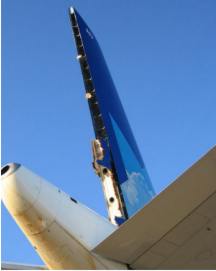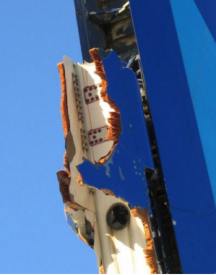
Links to the World Wide Web
and other NETcessities

What
made an Airbus rudder snap in mid-air?
At 35 000 feet above the
Caribbean, Air Transat flight 961 was heading home to Quebec with 270
passengers and crew. At 3.45pm last Sunday, the pilot noticed something
very unusual. His Airbus A310's rudder -- a structure over 8m high -- had
fallen off and tumbled into the sea. In the world of aviation, the shock
waves have yet to subside.

Click picture to enlarge
Entire rudder structure, an 8 meter high component,
goes missing on an Airbus A310 flight to Canada.
Mercifully, the crew was able to turn the plane around, and by steering it
with their wing and tail flaps managed to land at their point of departure
in Varadero, Cuba, without loss of life. But as Canadian investigators try
to discover what caused this near catastrophe, the specialist internet
bulletin boards used by pilots, accident investigators and engineers are
buzzing.
One former Airbus pilot, who now flies Boeings for a major United States
airline, told The Observer: "This just isn't supposed to
happen. No one I know has ever seen an airliner's rudder disintegrate like
that. It raises worrying questions about the materials and build of the
aircraft, and about its maintenance and inspection regime. We have to ask
as things stand, would evidence of this type of deterioration ever be
noticed before an incident like this in the air?"
He and his colleagues also believe that what happened may shed new light
on a previous disaster. In November 2001, 265 people died when American
Airlines flight 587, an Airbus A300 model which is almost identical to the
A310, crashed shortly after take-off from JFK airport in New York.
According to the official report into the crash, the immediate cause was
the loss of the plane's rudder and tailfin, though this was blamed on an
error by the pilots. Continue
Article
Air
Transit Caribbean to Canada flights no stranger to Airbus failure
In August 2001, an Air Transat Flight TS236 was en route
when the crew became aware of a fuel imbalance between the left and
right-wing main fuel tanks. Five minutes later the crew concerned about
the lower-that-expected fuel quantity indication, decided to divert to
Lajes Airport in the Azores.
When the crew determined that a fuel leak could be the reason for the possible fuel loss, an emergency was declared to Santa Maria Oceanic Control. At a distance of 135 miles from Lajes, the right engine (Rolls-Royce Trent 772B) flamed out. Thirteen minutes later when the aircraft was about 85 nm from Lajes the left engine flamed out.
From 13,000 feet and 8 miles from the threshold of the airport runway an engines-out visual approach was carried out and the aircraft landed on runway 33. As it did, eight of the plane's ten tires burst during the landing.
Investigation determined that a low-pressure fuel line on the right engine, had failed

